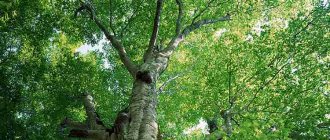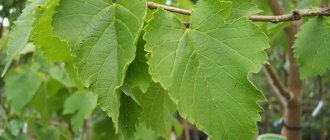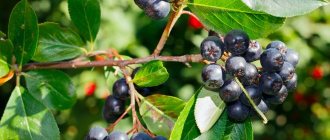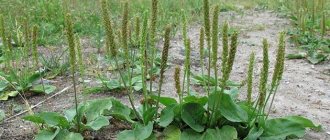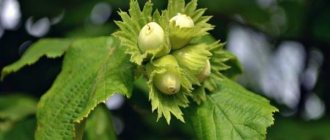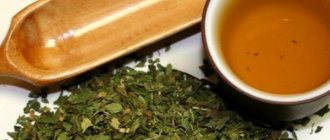Aspen tree description
Tree 25-30 m high, up to 1 m in diameter.
The crown is round, the trunk is cylindrical and columnar, the bark is greenish-gray. The leaves are round (in the crown of the tree), on long petioles, with palmate venation and a crenate-toothed edge. On coppice shoots, the leaves are larger, triangular-ovate with a pointed tip. Flower buds open in January, but blooms in March - May, before the leaves bloom.
Distributed from forest-steppe to northern taiga in Western Europe, the Caucasus, Western, Middle and Central Asia.
In Russia it grows in the European part, Siberia, and the Far East. Produces abundant root shoots. The wood is white, with a greenish tint, splits well, bends, and is easy to process. Burns quickly (although produces little heat).
The trunk is dark gray only at the bottom; above it is painted gray-green.
The trunks look most vibrant on young trees when their bark is wet with rain. In autumn, the crowns of aspen trees become very elegant: before they fall, the leaves turn different colors - from yellow to crimson-red.
Aspen in autumn
By the age of thirty, aspen is capable of producing more than 300 cubic meters of wood per hectare, the same as pine and spruce by 100 years.
It turns out that during the time it takes for the coniferous forest to ripen, you can get three harvests of aspen. It reproduces like all poplars: it reproduces by seeds, root suckers, and stump shoots. In our forests there are about 18 million hectares occupied by aspen trees; on 150 million hectares, aspen grows in proximity to other species.
Experts say that the areas occupied by this breed will increase. After all, after cutting down a mixed forest, which included at least one representative of aspen, its numerous offspring immediately occupy the cutting area.
The roots of the aspen, the one that grew as an impurity in the forest, spread wide and for decades, half asleep, remained viable, as if biding their time.
When a forest is cut down, a lot of moisture, light and heat appear. The roots awaken, and wild shoots emerge from dormant buds. Tiny flying aspen seeds are carried by the wind for tens of kilometers. Aspen and birch are always the first to populate open, free spaces, for which they are called pioneer trees.
Spreading
It is found on the border of forest and tundra, growing in forest and forest-steppe zones. It can be found along the banks of reservoirs, in forests, along forest edges, occasionally on dry sands and clearings, in ravines, swamps and in the mountains; rises to the upper border of the forest.
It grows well on various soils, forms pure aspen forests and is part of mixed forests along with coniferous (pine, larch, spruce) and deciduous (birch, alder, oak). In the steppes, colonies are formed from them - aspen stakes, growing from separate seedlings and reproducing through shoots of the root system; new stems in the colony can appear at a distance of up to 30-40 m from the parent tree. Some colonies become very large over time, spreading at a rate of about a meter per year, eventually covering several hectares. They are able to survive forest fires because the root system is located deep underground.
Distributed in Europe, Kazakhstan, China, Mongolia, on the Korean Peninsula, throughout Russia.
Included in the Red Book of the Chukotka Autonomous Okrug (2008).
Aspen tree
Only shade-tolerant spruce can survive aspen from the forest. The fact is that aspen is a light-loving plant, and its shoots are not capable of living under the canopy of other trees.
In winter, in the absence of leaves, aspen can be confused with poplar. Differences in location - poplars are usually not found in our forests, but aspens are rarely found in urban plantings. A more reliable difference is the kidneys. Poplars, typical of our urban plantings, have longer ones.
In summer, aspen can be confidently recognized by its rounded leaves with an uneven, notched edge.
The leaf is dark green above, light gray-green below, smooth on both sides. The arrangement of leaves and branches is regular.
Aspen leaves tremble at the slightest wind. The explanation lies in their structure. The long petioles are flattened and thinner in the middle. Aspen is a bisexual tree, pollinated by the wind.
Small female and male flowers are collected in greenish earrings. Aspen blooms in late April - early May, even before the leaves bloom. The fruits are small boxes covered with down, which allows the seeds to stay in the air longer and fly further from the tree that gave them birth.
Aspen is a tree that lives relatively short - usually 80-90 years. Only a few specimens live up to 120-140 years. One of the reasons is that the trunk core is easily affected by rot.
Wood is used to make matches, plywood, containers, cellulose and paper, and rayon.
Aspen is frost-resistant and light-loving, but in this respect it is somewhat inferior to birch. It is more demanding of soil fertility and moisture; it grows well on sandy loam, clayey, loamy fresh soils.
Lives 60-80(150) years. Trees emerging from root suckers are easily affected by rot; dried wood is durable and resistant to rot. Decoctions and infusions of buds, leaves and bark are used in medicine.
Climatic conditions
It grows almost everywhere in our country, with the exception of the polar regions. The breed is fast growing and usually lives up to eighty years (rarely reaching one hundred, in the best cases - up to two hundred).
Helpful information
However, foresters call aspen the pioneer of the forest. It, along with the birch, is the first to appear where there is at least the slightest opportunity to gain a foothold: a patch of bare soil, a fire pit, a steep slope of a quarry - if only there was at least a little moisture, the seed would definitely germinate!
Scientists observed the process of seed growth and saw a lot of interesting things. The seed sticks to the moist soil with its hairs, is pulled towards it and after a few hours its shell bursts, releasing two cotyledons. The tip of the cotyledon thickens, new hairs form on it, which begin to greedily absorb moisture, and a root begins to make its way down to the ground. In the first year of a young aspen, the root is sometimes buried into the soil up to thirty centimeters, only after which the above-ground part begins to develop more vigorously.
Often by autumn the aspen grows 20-25 centimeters and goes into the winter under the snow.
Features of growth
The genus of poplars (Populus) consists of 25-30 species, the most common being aspens. Trembling poplar or aspen. Scientific name: Populus tremula. Aspen leaves tremble at the slightest wind.
In winter, in the absence of leaves, aspen can be confused with poplar. Differences in location - poplars are usually not found in our forests, but aspens are rarely found in urban plantings. A more reliable difference is the kidneys. Poplars, typical of our urban plantings, have longer ones. In summer, aspen can be confidently recognized by its rounded leaves with an uneven, notched edge.
The leaf is dark green above, light gray-green below, smooth on both sides. The arrangement of leaves and branches is regular.
The use of aspen in folk medicine
Mostly in folk medicine, aspen bark is used, which is most valuable due to its composition. Products are made from it in a variety of forms: decoctions, infusions, alcohol tinctures and even ointments.
Decoctions and infusions from aspen
There are 3 main ways to make a decoction and infusion of aspen bark:
- Finely crushed bark is poured with clean water in a ratio of 1:4 . Place the container on low heat, wait until it boils and leave for another 30 minutes. After this time, the broth should sit for at least 6 more hours, tightly closed with a lid. This “greenhouse effect” will help the beneficial substances to be released into the water. If the bark was purchased at a pharmacy, then the boiling time is reduced to 5 minutes, since the raw material has already undergone heat treatment. This remedy is taken half a glass three times a day 30 minutes before meals. The decoction is especially useful for diabetes.
- An infusion of aspen bark is very useful for pulmonary tuberculosis and inflammatory diseases . To prepare it, 1 tbsp. a spoonful of raw material is poured into 0.5 liters of hot water and left for 12 hours. Drink a glass in the morning and evening.
- Otherwise, an infusion is prepared for the treatment of diabetes: the bark and boiling water are combined in a ratio of 1:3 and left for 10–12 hours. It is preferable to take the product in the morning on an empty stomach. Between courses of treatment, each of which lasts 3 weeks, there should be a 10-day break.
The most useful are decoctions and infusions immediately after preparation. Over time, the beneficial substances disappear from them. Although the liquid may have an unpleasant aftertaste, it is not recommended to sweeten it, even with sugar substitutes.
Aspen ointment
The ointment will help with areas of inflammation on the skin, burns and dermatitis. The bark should be burned, and the resulting ash (10 g) mixed with Vaseline (20 g). This remedy can be stored in the refrigerator and used if necessary until recovery. Very soon the unpleasant symptoms will disappear.
Tincture of aspen with vodka
A universal tincture of aspen with vodka suppresses inflammatory processes in the body, enhances the functioning of the immune system and improves health thanks to vitamins and minerals. To prepare it, you need to mix the bark and vodka: for 100 g of raw materials you will need 200 ml.
The bottle is placed in a dark place for 2 weeks. After this, you need to strain the liquid and consume 15–20 drops before meals. To make it easier to drink the tincture, it is diluted in a third of a glass of still mineral water.
How to brew aspen bark
Tea made from aspen bark is recommended for diabetics, people during the recovery period after infectious diseases, and also for prevention when there is a tendency to increase blood sugar levels. It is enough to pour a couple of glasses of boiling water over the bark (2 tablespoons) and leave it in a teapot or thermos for 30–60 minutes. Drink immediately after preparation.
Kvass from aspen for the treatment of diabetes
Aspen kvass is not only good for health and lowers sugar, but also pleasant on hot days because it is very refreshing. To prepare it, you will need a 3 liter jar. It is filled with either dry bark (a third of the container) or fresh bark (half a jar). Also add 2/3 cup granulated sugar, water and 1 teaspoon of fat sour cream. In a couple of weeks, the unusual and healing drink will be ready.
Main characteristics of aspen wood
Aspen blooms in early spring and about two weeks before the leaves bloom, from 7-15 years old, annually and more often - profusely. One tree has male catkins, which fall off after pollen ripens and leaves. On other trees only female flowers develop.
After pollination, they continue to develop, and after one and a half to two months the catkins open and release a huge mass of ripened seeds.
The seeds are very small, barely visible to the naked eye, but are equipped with a parachute and are therefore carried by the wind over long distances. One aspen tree produces up to one million seeds, from which only a few obtain life.
An aspen seed can hatch within twelve hours after it is separated from the mother tree. Having a small weight, an aspen seed also contains insignificant reserves of nutrients, so it can retain its viability only for a short time. .
It is estimated that up to five hundred million seeds are released from one hectare of aspen forest. Nature sows abundantly, but very few remain to live. The vast majority of aspen seeds die when exposed to drought, hanging in the grass, forest floor, remaining on roads, etc.
Bloom
Aspen is a bisexual tree, pollinated by the wind. Small female and male flowers are collected in greenish earrings. Aspen blooms in late April - early May, even before the leaves bloom.
Fruit
The fruits are small boxes covered with down, which allows the seeds to stay in the air longer and fly further from the tree that gave them birth.
Bark
The trunk is cylindrical, the bark is light green or greenish-gray
Leaves
The leaves are dense grayish-green, the petiole is almost equal in length to the leaf blade, flattened in a direction perpendicular to it, very elastic.
Therefore, even with a slight breath of wind, the leaves begin to vibrate and tremble.
Period of wearing foliage
August 1st decade, August 2nd decade, August 3rd decade, April 3rd decade, July 1st decade, July 2nd decade, July 3rd decade, June 1st decade, June 2 -1st decade, June 3rd decade, May 1st decade, May 2nd decade, May 3rd decade, October 1st decade, October 2nd decade, September 1st decade, September 2nd decade, September 3rd decade
Cones: color group
White
Pests
Fleas, Spider mites, Aphids
Relation to moisture
Moisture resistant
Soil type
Sod-podzolic
Foliage: color group
Green
Diseases
Leaf curl, Rust, Gray rot, Fusarium wilt
Barrel: color group
Multicolor
Attitude to heat
Frost-resistant
Flower/inflorescence size
Average
Light or shadow
Shade-tolerant
Typical purpose
Alley landing
Aspen is one of the most common trees in Central Russia. Its characteristic feature is light green, smooth bark. In the dark, it can be confused with birch, although if you touch the bark with your hands, the difference from birch bark is noticeable.
In winter, in the absence of leaves, aspen can be confused with poplar. Differences in location - poplars are usually not found in our forests, but aspens are rarely found in urban plantings. A more reliable difference is the kidneys. Poplars, typical of our urban plantings, have longer ones.
In summer, aspen can be confidently recognized by its rounded leaves with an uneven, notched edge. The leaf is dark green above, light gray-green below, smooth on both sides.
The arrangement of leaves and branches is regular.
Aspen leaves tremble at the slightest wind. The explanation lies in their structure. The long petioles are flattened and thinner in the middle.
Aspen is a bisexual tree, pollinated by the wind. Small female and male flowers are collected in greenish earrings. Aspen blooms in late April - early May, even before the leaves bloom.
The fruits are small boxes covered with down, which allows the seeds to stay in the air longer and fly further from the tree that gave them birth.
Aspen: how to distinguish a tree from others
Aspen is a tree that lives relatively short - usually 80-90 years. Only a few specimens live up to 120-140 years. One of the reasons is that the trunk core is easily affected by rot.
Aspen and birch are easy to distinguish. But if you rarely walk in the forest and don’t remember what these trees look like, this article will help you a lot.
You will be able to distinguish them even in winter.
Differences in bark
Birch is the only tree in the world with white bark. It is difficult to confuse it with other plants.
Due to growing conditions, it can acquire a greenish, yellowish, and in rare cases red and even black tint.
Another difference is the presence of black lentils and raised cracks.
Aspen bark is green-gray and can fade to beige or blue.
At the bottom it is usually rough. May have deep cracks. In the middle part of the trunk, it is smooth and has a green tint.
When splitting aspen firewood, the bark comes off in large pieces. Birch bark is thin and soft. Its top layer is birch bark, consisting of many thin layers. This is the most significant difference.
names of aspen trees
According to one version, the word “aspen” comes from the word “blue”.
The fact is that after the Aspen has been cut down or cut down, a blue discoloration forms at the site of the cut. This occurs due to tannins reacting with metal particles. This property is used by many carpenters and cabinetmakers when working with various species.
Since wood has a white tint, the blue tint is especially noticeable.
The Latin name for Common Aspen is populous tremula, which literally means “trembling man” in Latin.
By the leaves
Aspen leaves are dark green.
The shape is close to a circle. The part of the leaf facing the sun is glossy, rich green. The back side is matte, as if slightly dusty.
The leaf is attached to the branch by a long thin stalk. Because of this, aspen leaves tremble violently in the wind.
In autumn they turn yellow, and in some varieties they turn red.
Birch leaves are much smaller. They are easy to distinguish from the rest. The shape is classic, with serrated edges.
Young leaves are bright, juicy, green. Then they fade a little. In spring, the leaves are sticky and slightly stick to your hands.
Identify by flowers
Yes, yes, don’t be surprised, both the birch and aspen are blooming.
Only the flowers are not ordinary.
Earrings are birch flowers. They appear during the fruiting period. They consist of scales fused in the center, 2-4 cm long. In early spring they are green, and with the arrival of warmth they turn brown.
Aspen also has flowers. They are collected in earrings. A characteristic fluff is visible between the seeds. They are red and up to 15 cm long.
And green ones - they are thinner and shorter.
By fruit
Trees can also be distinguished by their fruits.
Aspen has elongated boxes consisting of 2 or 4 leaves. Inside there are many small seeds with a puff. Aspen blooms in late May early June.
The birch fruit resembles a nut with thin wings. The fruits are very light and small. 5000 nuts weigh 1 gram. They are easily carried by the wind.
Aspen: description, photo, range of applications
They can often be seen around birch trees, especially in winter.
Distinguish by branches
The branches of the birch are thin and look like a cobweb. Hanging branches do not have their own rigidity at all. The color of the thin branches is dark, one might say black.
They bend beautifully. They are used to weave wreaths and are actively used as bath brooms.
Aspen branches are very different. They are thick, dense, and not at all elastic.
It is difficult to bend an aspen branch; it is easier to break it. They do not differ in color from the trunk.
By juice
In the spring, before the leaves bloom, an active process of sap movement occurs inside the birch. It is popularly called birch tree. It is loved and collected by many people. It has a pleasant sweet taste. If you make an incision on the trunk in the spring, sap will begin to flow out.
Aspen also has sap flow.
But not so much. Aspen sap is bitter. And it has no culinary or medical significance.
For mushrooms
If you like to pick mushrooms, then this will also help differentiate the two trees.
There is an opinion that mushrooms grow under a certain type of tree.
So aspen boletus grows near aspens, and boletus grows where birch trees grow.
This popular observation has a right to life.
But you shouldn’t strictly focus on it.
Aspen, interesting facts
- Aspen is widespread in temperate and cold climate areas of Europe and Asia.
- Lives 80-90, rarely up to 150 years.
It grows very quickly, but at the same time suffers from wood diseases. Old, large and healthy individuals are a rarity.
- Aspen is distributed throughout Russia.
- Outside Russia, it is distributed in Europe, Kazakhstan, China, Mongolia, and the Korean Peninsula.
- Aspen bark is used for tanning leather.
It is used to produce yellow and green paint.
- The wood is used to build houses, used as roofing material (in Russian wooden architecture, church domes were covered with aspen planks), in the production of cellulose, plywood, matches, containers, etc.
- The trembling of aspen leaves in the Russian tradition is associated with an episode of the New Testament - the suicide of Judas Iscariot.
People consider aspen a cursed tree because, according to legend, Judas the Traitor hanged himself on it.
- Aspen is credited with the ability to ward off evil spirits: the witch is afraid of aspen.
If you stick aspen branches into the wattle fence of a fence, then a witch cannot enter such a fence and will not spoil the cows.
- It is believed that an aspen stake driven into the heart of a vampire can stop him.
- Sayings: Aspen makes noise even without the wind; Aspen trees will not produce oranges;
- It is said about a frightened person that he “trembles, shakes, “like an aspen leaf.”
- “Aspen does not burn without kerosene” (meaning the low value of aspen firewood as fuel)
- Wooden shoes were made in the Netherlands mainly from aspen.
Do you think the photo shows an aspen tree in the fall?
Golden leaves... Nothing like that, it's early spring.
The healing properties of aspen
Aspen is used not only in alternative medicine. Quite often it is also used in general complex treatment regimens, as an auxiliary, restorative and supportive agent.
The tree is so popular for one simple reason - it has numerous medicinal properties. A list of the therapeutic benefits of aspen bark, leaves and catkins is below.
- The collection eliminates inflammation, both when used externally and internally.
- Thanks to the content of antioxidants, vitamins and flavonoids, the plant strengthens the immune system and helps to quickly cope with bacterial and viral infections.
- Aspen has a pronounced diuretic effect, and due to the content of organic acids it helps with urolithiasis. Together with the antibacterial and anti-inflammatory effect, this property is used in the treatment of diseases of the urinary system.
- Aspen bark has a beneficial effect on the gallbladder and liver, stimulates cell restoration, and helps more actively process toxins and fats. Indicated for use in cases of congestion, cholecystitis, cholelithiasis, and hepatitis.
- The plant strengthens the heart, helps quickly cleanse blood vessels of cholesterol, tones their walls and increases elasticity.
- The plant has a mild laxative effect, restores microflora and intestinal motility.
- Aspen helps cope with a lingering cough. It eliminates its causes - inflammation in the respiratory tract and infections.
- Aspen is a popular anthelmintic that copes with various types of parasites without harm to health.
- The bark of the plant helps reduce sugar levels and regulate metabolic processes in diabetes mellitus.
- Using herbal medicine can reduce high blood pressure and normalize well-being in case of hypertension.
Thanks to the use of aspen-based products, you can generally improve your health, increase your resistance, and improve your well-being. Tea based on plant raw materials replenishes the deficiency of minerals, vitamins and antioxidants, adds vigor and strength.

